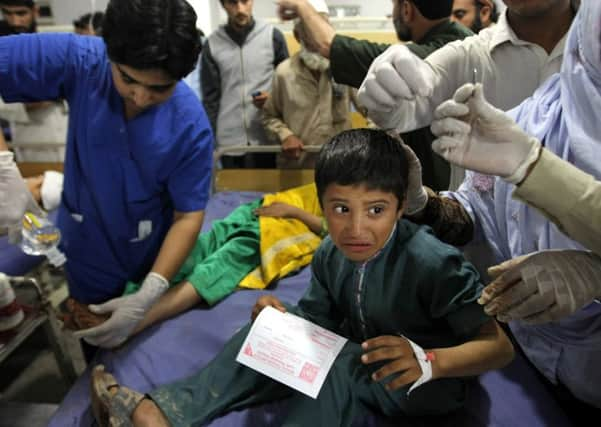Pakistan, Afghanistan earthquake death toll hits 339


According to Afghan and Pakistani officials, 258 people died in Pakistan and 78 in Afghanistan in the magnitude-7.5 quake, which was centred deep beneath the Hindu Kush mountains in Afghanistan’s sparsely populated Badakhshan province that borders Pakistan, Tajikistan and China.
Three people died on the Indian side of the disputed region of Kashmir.
Advertisement
Hide AdAdvertisement
Hide AdAfghan authorities were scrambling to access the hardest-hit areas near the epicentre, located 45 miles south of Fayzabad, the capital of Badakhshan province. Teams on foot were sent to the most remote regions to assess damage and casualties, but air relief drops were not expected to begin for some days.
In Pakistan, the Swat Valley and areas around Dir, Malakand and Shangla towns in the mountains of Khyber Pakhtunkhwa province were also hard-hit. Officials said 202 of the dead were killed in Khyber Pakhtunkhwa.
The Pakistani town closest to the epicenter is Chitral, while on the Afghan side it is the Jurm district of Badakhshan.
More than 2,000 people were injured in Monday’s earthquake which also damaged more than 4,000 homes in Pakistan.
In Afghanistan a health official confirmed there were 78 dead and 466 wounded, based on numbers reported by hospitals across the country.
“We believe the exact numbers are much higher because not all people bring the bodies to the hospitals so there are many that are not being counted. And there are still areas we don’t have access to so we are not aware of the situation there,” he added.
Badakhshan govenor Shah Waliullah Adeeb said more than 1,500 houses there were either destroyed or partially destroyed.
The province’s casualty figures of 11 dead and 25 injured “will rise by the end of the day, once the survey teams get to the remote areas and villages,” he added.
Advertisement
Hide AdAdvertisement
Hide AdHelicopters were needed to reach the most remote villages, many inaccessible by road at the best of times, he added. Now, landslides and falling rocks have blocked the few existing roads. Food and other essentials were ready to go, he said, but “getting there is not easy”.
Badakhshan is one of the poorest regions of Afghanistan, despite vast mineral deposits. It is often hit by earthquakes, but casualty figures are usually low because it is so sparsely populated, with fewer than one million people spread across its vast mountains and valleys. It also suffers from floods, snowstorms and mudslides.
In Baghlan, south-west of Badakhshan,a police spokesman reported at least three dead and 31 wounded.
More than 350 houses had been destroyed or damaged. He added the number was expected to rise as officials and relief workers reached remote districts.
Nangarhar province on the eastern border with Pakistan was particularly hard hit, despite its distance from the epicentre. A spokesman for the Nangarhar public health hospital, said at least 28 people died and 141 were wounded. More than 1,000 homes were destroyed and many livestock were killed.